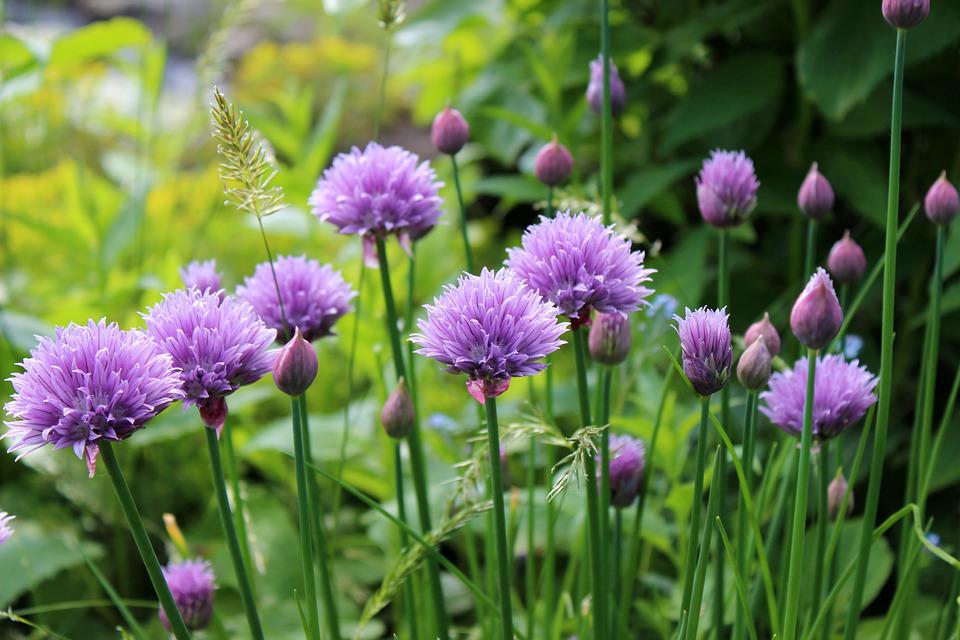Growing Chives: Simple Steps for a Flavorful Garden Harvest

Growing Chives
Growing chives rewards any gardener ready to roll up sleeves and dig into fresh herbs. To start growing chives, sprinkle seeds directly onto loose, fertile soil or plant young seedlings in sun-drenched pots. Keep soil moist but never soggy, and you'll snip mild, onion-flavored blades within weeks. Read on to learn how these resilient herbs flourish with minimal fuss.
I keep a clump of chives by the kitchen door because fresh snips beat any jarred herb by a mile. The plant forgives neglect, yet rewards regular trims with electric green regrowth.
Know your chives
Common chives (Allium schoenoprasum) bring a mild onion snap and lavender pom-pom blooms. Garlic chives (Allium tuberosum) taste garlicky, carry flat leaves, and bloom white later in summer.
Both are hardy perennials that spread in friendly clumps. Flavor peaks when leaves grow fast and steady.
Climate, sun, and season
Chives thrive in USDA Zones 3 to 9, which matches a wide swath of gardens. Aim for full sun, at least 6 hours, though light afternoon shade helps in hot summers.
They shrug off chill and return each spring. Winter mulch buys you an earlier restart in cold regions.
Soil that keeps them happy
Target a loamy, well drained bed with a pH between 6.0 and 7.0. Add compost to sandy or tight clay soils for moisture balance and steady nutrients.
Good drainage prevents crown rot. I raise containers slightly on pot feet to keep roots out of cold puddles.
Starting from seed or division
Sow seeds 0.25 inch deep, keep evenly moist, and expect sprouts in 7 to 14 days at 68 to 72 F, 20 to 22 C. Thin to clumps 6 to 8 inches apart, since they prefer growing in small colonies.
Dividing mature clumps takes two minutes and works spring or early fall. Split with a hori-hori or spade, then replant crowns so the leaf bases sit at soil level.
Containers that prosper
Use a pot at least 8 inches wide per clump with a peat-free mix that drains well yet holds moisture. I blend potting mix with 20 percent compost and a scoop of perlite.
Water until it drips from the base, then let the top inch dry. Indoor pots love bright south or west windows, or supplemental lights.
Water and feeding rhythm
Give roughly 1 inch, 25 mm, of water per week, more in heat or wind. Consistent moisture keeps leaves tender and sweet.
Feed lightly with a balanced organic fertilizer, 5-5-5, once in spring and again midseason. Too much nitrogen fattens leaves and dulls flavor.
Harvest for flavor and vigor
Start cutting when leaves reach 6 to 8 inches, 15 to 20 cm. Slice cleanly 1 to 2 inches above the crown, never scalping the plant.
Regular shearing every 2 to 3 weeks keeps chives leafy, delays flowering, and multiplies yields.
Flower buds taste great too. I pinch a handful for compound butter or floral vinegar.
Flower power, pollinators, and self-seeding
Chive blossoms feed bees during that early summer gap between spring bulbs and peak perennials. The Royal Horticultural Society describes chives as reliable pollinator plants that also earn space in small gardens.
Let a few heads bloom for the pollinators, then deadhead to prevent a seedling carpet. For nonstop leaves, prioritize bud removal.
Overwintering and renewal
In-ground clumps handle cold with ease across their hardiness range. I top-dress with compost in late fall, then a light mulch once the ground cools.
Revive sluggish clumps by dividing every 2 to 3 years. Freshly split plants shoot out finer, tastier leaves.
Pests and diseases, handled simply
Onion thrips and aphids appear in hot, dry spells. A strong water spray and a weekly neem or insecticidal soap cycle usually clears them.
Watch for rust or leaf spots that follow tight spacing and shade. Improve airflow, trim affected leaves, and water at the base in the morning.
Companions worth planting
Chives border beds neatly and play well with tomatoes, peppers, carrots, beets, and strawberries. I tuck them near roses since they seem to discourage aphids.
A living edging of chives also buffers soil splash on salad greens. The clumps look tidy and taste better.
Indoors under lights
Set LED grow lights at 4 to 6 inches above the canopy with a daylight spectrum around 4000 to 6500 K. Run 12 to 14 hours per day for sturdy leaves.
Turn the pot a quarter-turn weekly for even growth. Keep indoor temperatures near 60 to 70 F, 16 to 21 C.
Preserving the haul
For peak flavor, freeze rather than dry. Snip clean leaves, pat dry, then bag in thin layers or freeze in olive oil cubes.
Chive blossom vinegar turns a luminous pink after a week in the jar. It wakes up potato salad and grilled fish.
Buying guide: seed, starts, tools, and useful extras
- Seed or starts: choose reputable suppliers for fresh seed, viability drops after 1 to 2 years.
- Varieties: ‘Staro’ and ‘Fine Leaf’ for dense, upright growth, ‘Profusion’ for extended bloom, garlic chives ‘Geisha’ for broad leaves and white flowers.
- Containers: 8 to 12 inch wide pots with large drainage holes, saucers optional outdoors.
- Soil: peat-free potting mix with added perlite, skip garden soil in pots.
- Shears: springy herb scissors for clean cuts that do not crush leaves.
- Fertilizer: balanced organic granular or fish hydrolysate for light monthly feeding in containers.
- Grow lights: full-spectrum LED bars or panels with timer, 12 to 14 hours daily.
Quick start: Growing Chives from seed to first cut
- Sow shallowly in trays or pots, keep moist, warm to 68 to 72 F, 20 to 22 C.
- Transplant clumps after 4 to 6 weeks, spacing 6 to 8 inches.
- Water weekly and mulch lightly to hold moisture.
- First haircut at 8 to 10 weeks, then every few weeks through the season.
Common mistakes I see, and simple fixes
- Scalping the plant, always leave 1 to 2 inches of green above the crown.
- Watering in the evening, switch to morning to limit disease.
- Overfeeding with nitrogen, flavor drops and leaves flop.
- Dense, shaded clumps, divide and replant for airflow and light.
- Letting all buds bloom, save some for bees and shear the rest for leaf production.
Data-backed notes and expert references
USDA Plant Hardiness guidance places chives as a cold-hardy perennial across Zones 3 to 9. University extensions, including Minnesota and Illinois, recommend full sun, steady moisture, and division every few years for vigor.
RHS materials highlight chives as reliable in containers and borders with edible flowers that attract pollinators. These recommendations match what I see in production beds and home plots.
FAQ, fast answers from the field
Do chives regrow after cutting, yes, faster in warm weather with steady moisture and light feeding. I schedule trims every 2 to 3 weeks for a rolling harvest.
Can I grow chives in part shade, yes, although yields drop, aim for morning sun and bright afternoon shade. Container plants in shade need less water.
How deep are roots, most sit in the top 6 inches, 15 cm, so avoid deep cultivation. Use shallow weeding tools near the clump.
Can I grow chives hydroponically, yes, they respond well to 1.5 to 2.0 EC and mild, balanced nutrients. Keep solution temps near 65 to 70 F, 18 to 21 C.
Are chives safe for pets, all alliums can be toxic to cats and dogs in quantity. Keep harvests in the kitchen and spent stems in sealed compost.
My field notes for peak flavor
Flavor rides on growth rate. If leaves slow or toughen, I boost water on hot weeks, pinch every bud, and top-dress with compost.
I also rotate clumps between beds every few years to dodge soil fatigue. Fresh ground, fresh growth.
Cheatsheet: Fast, Flavorful Chive Harvests
🌱 Choose Location & Soil
Plant in full sun or partial shade. Use well-draining, rich soil. Ideal pH: 6.0–7.0.
🌡️ Planting Tips
- Sow seeds indoors 6 weeks before last frost or direct sow after danger of frost.
- Spacing: 6–8 in (15–20 cm) apart.
- Soil temp: 60–70°F (16–21°C).
- Cover thinly—seeds need light to germinate.
💧 Watering & Care
- Keep soil consistently moist but not soggy.
- Mulch to retain moisture.
- Fertilize with balanced organic feed every 6 weeks.
✂️ Harvest & Use
- Cut leaves when 6 in (15 cm) tall.
- Snip outer leaves first; avoid cutting more than ⅓ at once.
- Perennial: Grows back for 3–5 years.
- Chives contain vitamins A, C, K and antioxidants.
🛠️ Tools and Products You'll Need
- Chive seeds or starts
- Trowel
- Watering can
- Sharp scissors or herb snips
- Compost or organic fertilizer
- Mulch
🌸 Extra Savory Tips
- Flowers attract pollinators & are edible.
- Divide clumps every 2–3 years for best yields.
- Freshly snipped chives lose 50% flavor in 24 hrs—use promptly.
- Grow indoors for fresh greens year-round.
Frequently Asked Questions about Growing Chives
What is the ideal location for planting chives?
Chives thrive in full sun, receiving at least 6 to 8 hours of direct sunlight daily. Select a location with well-draining soil and adequate air circulation to encourage healthy growth.
How deep should chives be planted?
Plant chive seeds about ¼ inch (0.5 cm) deep, lightly covering them with soil. For transplanting seedlings or divisions, set them at the same soil level they grew previously, spacing plants 8 to 12 inches (20-30 cm) apart.
What soil type benefits chive growth?
Chives favor a rich, loamy soil with a neutral to slightly acidic pH between 6.0 and 7.0. Enrich your planting bed with compost or organic matter to support vigorous growth.
How frequently should chives be watered?
Keep the soil evenly moist but avoid waterlogged conditions. Provide approximately 1 inch (2.5 cm) of water per week, adjusting based on rainfall and temperature conditions.
Do chives need fertilizer?
Feed chives sparingly with a balanced, organic fertilizer or compost tea in early spring. Excessive fertilizing can weaken flavor and lead to overly lush foliage.
When and how can chives be harvested?
Harvest chive leaves once they reach about 6 inches (15 cm) in length. Snip the outer leaves near the soil level, encouraging new growth. Regular harvesting sustains plant vigor and maximizes flavor.
Can chives withstand cold weather?
Yes, chives are hardy perennials that withstand temperatures as low as -30°F (-34°C). In colder climates, apply a layer of mulch around plants during winter to protect the roots.
How do you propagate chives?
Propagate chives by dividing mature clumps every 2 to 3 years, preferably in early spring or fall. Gently separate the clump, planting divisions immediately at the appropriate spacing.
What companion plants pair best with chives?
Chives pair especially well with tomatoes, carrots, roses, and apple trees. Their strong fragrance naturally deters pests like aphids and enhances the growth and flavor of nearby plants.
Growing chives is about simplicity and flavor. A handful of sun, well-drained soil, and the occasional trim will keep your patch thriving. Their slender, green stalks are tough, coming back year after year, asking for little but giving plenty. Snip them fresh over eggs, salad, or buttered potatoes, and you’ll taste why this herb deserves a spot in every garden. For those who crave more edible variety, consider growing borage alongside your chives for a different twist. In the end, the best gardens are made up of plants that pull double duty—easy to grow, and generous on the plate. Chives tick both boxes, every time.



